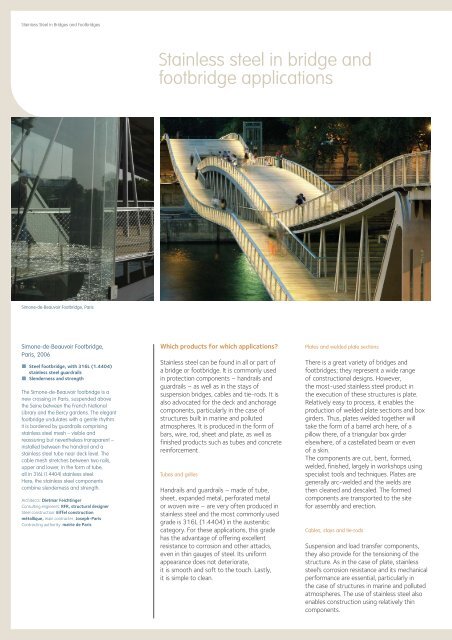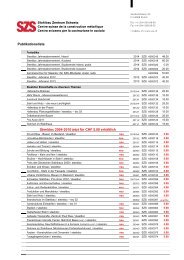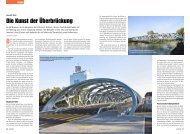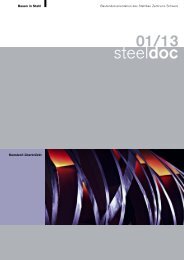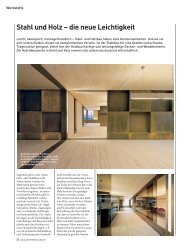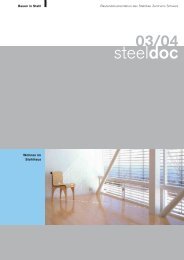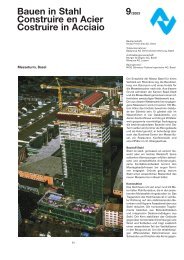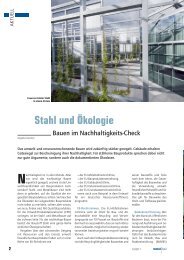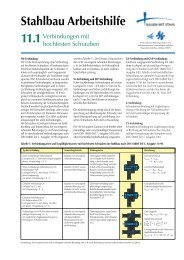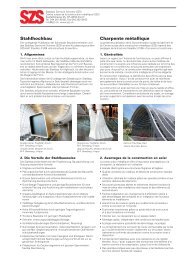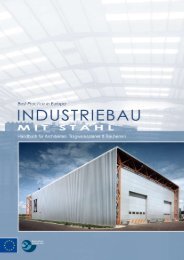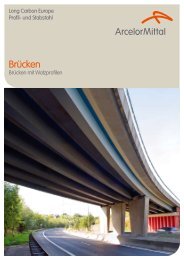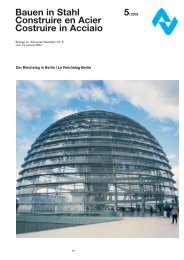Stainless Steel in Bridges and Footbridges
Stainless Steel in Bridges and Footbridges
Stainless Steel in Bridges and Footbridges
Create successful ePaper yourself
Turn your PDF publications into a flip-book with our unique Google optimized e-Paper software.
<strong>Sta<strong>in</strong>less</strong> <strong>Steel</strong> <strong>in</strong> <strong>Bridges</strong> <strong>and</strong> <strong>Footbridges</strong><br />
Simone-de-Beauvoir Footbridge, Paris<br />
Simone-de-Beauvoir Footbridge,<br />
Paris, 2006<br />
■IIII <strong>Steel</strong> footbridge, with 316L (1.4404)<br />
sta<strong>in</strong>less steel guardrails<br />
■IIII Slenderness <strong>and</strong> strength<br />
The Simone-de-Beauvoir footbridge is a<br />
new cross<strong>in</strong>g <strong>in</strong> Paris, suspended above<br />
the Se<strong>in</strong>e between the French National<br />
Library <strong>and</strong> the Bercy gardens. The elegant<br />
footbridge undulates with a gentle rhythm.<br />
It is bordered by guardrails compris<strong>in</strong>g<br />
sta<strong>in</strong>less steel mesh – visible <strong>and</strong><br />
reassur<strong>in</strong>g but nevertheless transparent –<br />
<strong>in</strong>stalled between the h<strong>and</strong>rail <strong>and</strong> a<br />
sta<strong>in</strong>less steel tube near deck level. The<br />
cable mesh stretches between two rails,<br />
upper <strong>and</strong> lower, <strong>in</strong> the form of tube,<br />
all <strong>in</strong> 316L (1.4404) sta<strong>in</strong>less steel.<br />
Here, the sta<strong>in</strong>less steel components<br />
comb<strong>in</strong>e slenderness <strong>and</strong> strength.<br />
Architects: Dietmar Feicht<strong>in</strong>ger<br />
Consult<strong>in</strong>g eng<strong>in</strong>eers: RFR, structural designer<br />
<strong>Steel</strong> construction: Eiffel construction<br />
métallique, ma<strong>in</strong> contracter; Joseph-Paris<br />
Contract<strong>in</strong>g authority: mairie de Paris<br />
<strong>Sta<strong>in</strong>less</strong> steel <strong>in</strong> bridge <strong>and</strong><br />
footbridge applications<br />
Which products for which applications?<br />
<strong>Sta<strong>in</strong>less</strong> steel can be found <strong>in</strong> all or part of<br />
a bridge or footbridge. It is commonly used<br />
<strong>in</strong> protection components – h<strong>and</strong>rails <strong>and</strong><br />
guardrails – as well as <strong>in</strong> the stays of<br />
suspension bridges, cables <strong>and</strong> tie-rods. It is<br />
also advocated for the deck <strong>and</strong> anchorage<br />
components, particularly <strong>in</strong> the case of<br />
structures built <strong>in</strong> mar<strong>in</strong>e <strong>and</strong> polluted<br />
atmospheres. It is produced <strong>in</strong> the form of<br />
bars, wire, rod, sheet <strong>and</strong> plate, as well as<br />
f<strong>in</strong>ished products such as tubes <strong>and</strong> concrete<br />
re<strong>in</strong>forcement.<br />
Tubes <strong>and</strong> grilles<br />
H<strong>and</strong>rails <strong>and</strong> guardrails – made of tube,<br />
sheet, exp<strong>and</strong>ed metal, perforated metal<br />
or woven wire – are very often produced <strong>in</strong><br />
sta<strong>in</strong>less steel <strong>and</strong> the most commonly used<br />
grade is 316L (1.4404) <strong>in</strong> the austenitic<br />
category. For these applications, this grade<br />
has the advantage of offer<strong>in</strong>g excellent<br />
resistance to corrosion <strong>and</strong> other attacks,<br />
even <strong>in</strong> th<strong>in</strong> gauges of steel. Its uniform<br />
appearance does not deteriorate,<br />
it is smooth <strong>and</strong> soft to the touch. Lastly,<br />
it is simple to clean.<br />
Plates <strong>and</strong> welded plate sections<br />
There is a great variety of bridges <strong>and</strong><br />
footbridges; they represent a wide range<br />
of constructional designs. However,<br />
the most-used sta<strong>in</strong>less steel product <strong>in</strong><br />
the execution of these structures is plate.<br />
Relatively easy to process, it enables the<br />
production of welded plate sections <strong>and</strong> box<br />
girders. Thus, plates welded together will<br />
take the form of a barrel arch here, of a<br />
pillow there, of a triangular box girder<br />
elsewhere, of a castellated beam or even<br />
of a sk<strong>in</strong>.<br />
The components are cut, bent, formed,<br />
welded, f<strong>in</strong>ished, largely <strong>in</strong> workshops us<strong>in</strong>g<br />
specialist tools <strong>and</strong> techniques. Plates are<br />
generally arc-welded <strong>and</strong> the welds are<br />
then cleaned <strong>and</strong> descaled. The formed<br />
components are transported to the site<br />
for assembly <strong>and</strong> erection.<br />
Cables, stays <strong>and</strong> tie-rods<br />
Suspension <strong>and</strong> load transfer components,<br />
they also provide for the tension<strong>in</strong>g of the<br />
structure. As <strong>in</strong> the case of plate, sta<strong>in</strong>less<br />
steel’s corrosion resistance <strong>and</strong> its mechanical<br />
performance are essential, particularly <strong>in</strong><br />
the case of structures <strong>in</strong> mar<strong>in</strong>e <strong>and</strong> polluted<br />
atmospheres. The use of sta<strong>in</strong>less steel also<br />
enables construction us<strong>in</strong>g relatively th<strong>in</strong><br />
components.


